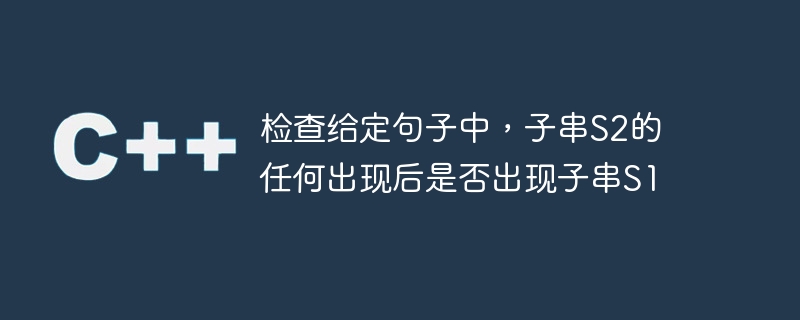检查给定句子中,子串S2的任何出现后是否出现子串S1

在这个问题中,我们需要检查子字符串S1是否出现在给定字符串S中子字符串S2的任何出现之后。我们可以比较S1和S2在字符串S中的起始索引来解决这个问题。 p>
问题陈述——我们给出了三个子字符串,名为 S、S1 和 S2。字符串 S 始终包含 S1 作为子字符串。我们需要检查给定字符串 S 中子字符串 S1 是否出现在子字符串 S2 出现之后。
示例
输入– S =“abxtutorialspointwelcomepoint”,S1 =“欢迎”,S2 =“点”;
输出 – 是
解释 – 在字符串 S 中,“point”子字符串出现了 2 次。一个在“欢迎”之前,另一个在“欢迎”之后。所以,我们可以说字符串 S1 出现在字符串 S2 的任何出现之后
输入– S = "abcdefgh", S1 = "abcd", S2 = "gh";
输出 – 否
解释S1位于字符串S的开头。因此,S1不会出现在子字符串S2之后。
输入– S =“abce”,S1 =“bc”,S2 =“xy”;
输出 – 否
说明 – 由于字符串 S2 不存在于字符串 S 中,因此打印 No。
方法 1
在这种方法中,我们将找到 S2 子字符串的所有起始索引并将它们存储在集合中。之后,我们将得到S1的起始索引。我们将 S2 的每个起始索引与 S1 的起始索引进行比较,如果我们发现集合中的任何值小于 S2 的起始索引,则可以说子字符串 S1 出现在子字符串 S2 的任何出现之后。
算法
定义存储子串S2起始索引的集合。
使用 find() 方法查找 S2 子字符串的第一个起始索引。
使用while循环获取子字符串S2的所有起始索引,并使用insert()方法将它们存储到集合中。
遍历设定值。如果任何值小于给定字符串 S 中子字符串 S1 的起始索引,则返回 true。
最后返回 false。
示例
#include <iostream>
#include <string>
#include <unordered_set>
using namespace std;
bool isS1AfterS2(string& S, string& S1, string& S2) {
// set to store indices of S2 in S
unordered_set<int> indices;
// Find all occurrences of S2 in S, and store them in set
size_t found = S.find(S2);
while (found != string::npos) {
indices.insert(found);
found = S.find(S2, found + 1);
}
// Compare starting indices of S1 with S2
for (const int& index : indices) {
if (index < S.find(S1)) {
return true; // S2 appears before S1
}
}
return false; // S1 appears before or at the same position as S2
}
int main(){
string S = "abxtutorialspointwelcomepoint";
string S1 = "welcome", S2 = "point";
if(isS1AfterS2(S, S1, S2)) {
cout << "Yes, string S1 appears after string S2.";
} else {
cout << "No, string S1 does not appear after string S2.";
}
return 0;
}
输出
Yes, string S1 appears after string S2.
时间复杂度 - O(N*K),因为我们需要找到字符串 S2 的起始索引。
空间复杂度 - O(N),因为我们存储字符串 S2 的起始索引。
方法2
在这种方法中,我们将遍历字符串。如果我们发现 S2 在 S1 出现之前出现,则返回 true,因为字符串 S 始终包含字符串 S1。
算法
定义len、n1和n2变量来存储变量的长度。
开始遍历字符串。
定义‘temp 字符串,并使用从第 i 个索引开始的长度为 n2 的子字符串对其进行初始化。
如果 temp == S2,则返回 true。
从第 i 个索引开始取长度为 n1 的子字符串。如果 temp == s1,则返回 false。
最后返回true。
示例
#include <bits/stdc++.h>
using namespace std;
bool isS1AfterS2(string &S, string &S1, string &S2){
// store the length of the strings
int n1 = S1.size(), n2 = S2.size();
// Traverse the string S from left to right
for (int i = 0; i <= S.size() - n2; i++){
// temporary string to store substring
string temp;
// get the substring
temp = S.substr(i, n2);
// if we find the string S2, return true as s1 always present in s.
if (temp == S2){
return true;
}
temp = S.substr(i, n1);
// If we find s1 before s2, return false
if (temp == S1){
return false;
}
}
return true;
}
int main(){
string S = "abxtutorialspointwelcome";
string S1 = "welcome", S2 = "point";
if(isS1AfterS2(S, S1, S2)) {
cout << "Yes, string S1 appears after string S2.";
} else {
cout << "No, string S1 does not appear after string S2.";
}
return 0;
}
输出
Yes, string S1 appears after string S2.
时间复杂度 – O(N*min(n1, n2)),因为我们找到长度为 n1 和 n2 的子字符串。
空间复杂度 - O(min(n1, n2),因为我们存储子字符串。
在第一种方法中,我们使用集合来存储S2的起始索引,这比第二种方法的代码需要更多的空间。第二种方法的代码比第一种方法更具可读性。另外,程序员可以尝试解决检查子串S2是否出现在S1出现之后的问题。
以上是检查给定句子中,子串S2的任何出现后是否出现子串S1的详细内容。更多信息请关注PHP中文网其他相关文章!

热AI工具

Undresser.AI Undress
人工智能驱动的应用程序,用于创建逼真的裸体照片

AI Clothes Remover
用于从照片中去除衣服的在线人工智能工具。

Undress AI Tool
免费脱衣服图片

Clothoff.io
AI脱衣机

AI Hentai Generator
免费生成ai无尽的。

热门文章

热工具

记事本++7.3.1
好用且免费的代码编辑器

SublimeText3汉化版
中文版,非常好用

禅工作室 13.0.1
功能强大的PHP集成开发环境

Dreamweaver CS6
视觉化网页开发工具

SublimeText3 Mac版
神级代码编辑软件(SublimeText3)

热门话题
 如何在Python中检查应用程序是否打开?
Aug 26, 2023 pm 06:49 PM
如何在Python中检查应用程序是否打开?
Aug 26, 2023 pm 06:49 PM
正在执行的程序称为进程。进程可以是当前操作系统上运行的应用程序,也可以是与操作系统相关的应用程序。如果一个应用程序与操作系统相关,它首先会创建一个进程来执行自己。其他应用程序依赖操作系统服务来执行。大多数应用程序是操作系统服务以及维护操作系统、软件和硬件的后台应用程序。在python中,我们有不同的方法来检查应用程序是否打开。让我们一一详细了解它们。使用psutil.process_iter()函数psutil是python中的一个模块,它为用户提供一个接口来检索正在运行的进程和系统利用率的信息
![拼写检查在团队中不起作用[修复]](https://img.php.cn/upload/article/000/887/227/170968741326618.jpg?x-oss-process=image/resize,m_fill,h_207,w_330) 拼写检查在团队中不起作用[修复]
Mar 06, 2024 am 09:10 AM
拼写检查在团队中不起作用[修复]
Mar 06, 2024 am 09:10 AM
我们已经开始注意到,有时拼写检查停止工作的团队。拼写检查是有效沟通的基本工具,任何对它的打击都会对工作流程造成相当大的破坏。在本文中,我们将探讨拼写检查可能无法按预期运行的常见原因,以及如何将其恢复到以前的状态。所以,如果拼写检查在团队中不起作用,请遵循本文中提到的解决方案。为什么Microsoft拼写检查不起作用?Microsoft拼写检查无法正常工作可能有多种原因。这些原因包括不兼容的语言设置、拼写检查功能被禁用、MSTeam或MSOffice安装损坏等。另外,过时的MSTeams和MSOf
 如何在Python中检查一个对象是否可迭代?
Aug 25, 2023 pm 10:05 PM
如何在Python中检查一个对象是否可迭代?
Aug 25, 2023 pm 10:05 PM
可迭代对象是可以使用循环或可迭代函数迭代其所有元素的对象。列表、字符串、字典、元组等都称为可迭代对象。在Python语言中,有多种方法可以检查对象是否可迭代。让我们一一看看。使用循环在Python中,我们有两种循环技术,一种是使用“for”循环,另一种是使用“while”循环。使用这两个循环中的任何一个,我们可以检查给定的对象是否可迭代。示例在这个例子中,我们将尝试使用“for”循环迭代一个对象并检查它是否被迭代。以下是代码。l=["apple",22,"orang
 Windows11中如何检查 SSD 运行状况?Win11上检查 SSD 运行状况的方法
Feb 14, 2024 pm 08:21 PM
Windows11中如何检查 SSD 运行状况?Win11上检查 SSD 运行状况的方法
Feb 14, 2024 pm 08:21 PM
Windows11中如何检查SSD运行状况?对于其快速的读取、写入和访问速度,SSD正在迅速取代HDD,但即使它们更可靠,您仍然需要在Windows11中检查SSD的运行状况。怎么去操作呢?本篇教程小编就来为大家分享一下方法吧。方法一:使用WMIC1、使用按键组合Win+R,键入wmic,然后按或单击“确定”。Enter2、现在,键入或粘贴以下命令以检查SSD运行状况:diskdrivegetstatus如果您收到“状态:正常”消息,则您的SSD驱动器运行正
 如何在Java中检查ArrayList是否包含某个元素?
Sep 03, 2023 pm 04:09 PM
如何在Java中检查ArrayList是否包含某个元素?
Sep 03, 2023 pm 04:09 PM
您可以利用List接口的contains()方法来检查列表中是否存在对象。contains()方法booleancontains(Objecto)如果此列表包含指定的元素,则返回true。更正式地说,如果且仅当此列表包含至少一个元素e,使得(o==null?e==null:o.equals(e)),则返回true。参数c-要测试其在此列表中是否存在的元素。返回值如果此列表包含指定的元素,则返回true。抛出ClassCastException-如果指定元素的类型与此列表不兼容(可选)。NullP
 Golang中如何检查字符串是否以特定字符开头?
Mar 12, 2024 pm 09:42 PM
Golang中如何检查字符串是否以特定字符开头?
Mar 12, 2024 pm 09:42 PM
Golang中如何检查字符串是否以特定字符开头?在使用Golang编程时,经常会遇到需要检查一个字符串是否以特定字符开头的情况。针对这一需求,我们可以使用Golang中的strings包提供的函数来实现。接下来将详细介绍如何使用Golang检查字符串是否以特定字符开头,并附上具体的代码示例。在Golang中,我们可以使用strings包中的HasPrefix
 Java程序用于检查TPP学生是否有资格参加面试
Sep 06, 2023 pm 10:33 PM
Java程序用于检查TPP学生是否有资格参加面试
Sep 06, 2023 pm 10:33 PM
请考虑下表了解不同公司的资格标准-CGPA的中文翻译为:绩点平均成绩符合条件的公司大于或等于8谷歌、微软、亚马逊、戴尔、英特尔、Wipro大于或等于7教程点、accenture、Infosys、Emicon、Rellins大于或等于6rtCamp、Cybertech、Skybags、Killer、Raymond大于或等于5Patronics、鞋子、NoBrokers让我们进入java程序来检查tpp学生参加面试的资格。方法1:使用ifelseif条件通常,当我们必须检查多个条件时,我们会使用
 在C语言中编写一个程序,用于检查给定的年份是否为闰年
Sep 20, 2023 pm 03:33 PM
在C语言中编写一个程序,用于检查给定的年份是否为闰年
Sep 20, 2023 pm 03:33 PM
闰年有366天,而普通年有365天,任务是通过程序检查给定的年份是否为闰年。判断的逻辑可以通过检查年份是否能被400或4整除来实现,但如果不能被这两个数整除,则为普通年。示例Input-:year=2000Output-:2000isaLeapYearInput-:year=101Output-:101isnotaLeapyear算法StartStep1->declarefunctionbooltocheckifyearifaleapyearornotboolcheck(intye






